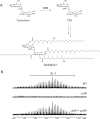Sulfolipid-1 biosynthesis restricts Mycobacterium tuberculosis growth in human macrophages
- PMID: 22360425
- PMCID: PMC3355658
- DOI: 10.1021/cb200311s
Sulfolipid-1 biosynthesis restricts Mycobacterium tuberculosis growth in human macrophages
Abstract
Mycobacterium tuberculosis (Mtb), the causative agent of tuberculosis, is a highly evolved human pathogen characterized by its formidable cell wall. Many unique lipids and glycolipids from the Mtb cell wall are thought to be virulence factors that mediate host-pathogen interactions. An intriguing example is Sulfolipid-1 (SL-1), a sulfated glycolipid that has been implicated in Mtb pathogenesis, although no direct role for SL-1 in virulence has been established. Previously, we described the biochemical activity of the sulfotransferase Stf0 that initiates SL-1 biosynthesis. Here we show that a stf0-deletion mutant exhibits augmented survival in human but not murine macrophages, suggesting that SL-1 negatively regulates the intracellular growth of Mtb in a species-specific manner. Furthermore, we demonstrate that SL-1 plays a role in mediating the susceptibility of Mtb to a human cationic antimicrobial peptide in vitro, despite being dispensable for maintaining overall cell envelope integrity. Thus, we hypothesize that the species-specific phenotype of the stf0 mutant is reflective of differences in antimycobacterial effector mechanisms of macrophages.
Figures





Similar articles
-
Mycobacterium tuberculosis (Mtb) lipid mediated lysosomal rewiring in infected macrophages modulates intracellular Mtb trafficking and survival.J Biol Chem. 2020 Jul 3;295(27):9192-9210. doi: 10.1074/jbc.RA120.012809. Epub 2020 May 18. J Biol Chem. 2020. PMID: 32424041 Free PMC article.
-
Multiple deletions in the polyketide synthase gene repertoire of Mycobacterium tuberculosis reveal functional overlap of cell envelope lipids in host-pathogen interactions.Cell Microbiol. 2014 Feb;16(2):195-213. doi: 10.1111/cmi.12214. Epub 2013 Oct 16. Cell Microbiol. 2014. PMID: 24028583
-
Mycobacterium tuberculosis Sulfolipid-1 Activates Nociceptive Neurons and Induces Cough.Cell. 2020 Apr 16;181(2):293-305.e11. doi: 10.1016/j.cell.2020.02.026. Epub 2020 Mar 5. Cell. 2020. PMID: 32142653 Free PMC article.
-
Lipoarabinomannan, and its related glycolipids, induce divergent and opposing immune responses to Mycobacterium tuberculosis depending on structural diversity and experimental variations.Tuberculosis (Edinb). 2016 Jan;96:120-30. doi: 10.1016/j.tube.2015.09.005. Epub 2015 Oct 28. Tuberculosis (Edinb). 2016. PMID: 26586646 Review.
-
New insights into the interaction of Mycobacterium tuberculosis and human macrophages.Future Microbiol. 2014;9(3):327-41. doi: 10.2217/fmb.13.164. Future Microbiol. 2014. PMID: 24762307 Review.
Cited by
-
The Mycobacterium tuberculosis MmpL11 Cell Wall Lipid Transporter Is Important for Biofilm Formation, Intracellular Growth, and Nonreplicating Persistence.Infect Immun. 2017 Jul 19;85(8):e00131-17. doi: 10.1128/IAI.00131-17. Print 2017 Aug. Infect Immun. 2017. PMID: 28507063 Free PMC article.
-
Chemical Synthesis of Cell Wall Constituents of Mycobacterium tuberculosis.Chem Rev. 2021 Aug 11;121(15):9554-9643. doi: 10.1021/acs.chemrev.1c00043. Epub 2021 Jun 30. Chem Rev. 2021. PMID: 34190544 Free PMC article. Review.
-
Various Facets of Pathogenic Lipids in Infectious Diseases: Exploring Virulent Lipid-Host Interactome and Their Druggability.J Membr Biol. 2020 Oct;253(5):399-423. doi: 10.1007/s00232-020-00135-0. Epub 2020 Aug 24. J Membr Biol. 2020. PMID: 32833058 Free PMC article. Review.
-
Single and Combined Serum Proteins Expressed in TB Infection are Candidates for Point-of-care Diagnostic Testing of Active TB Patients in Lambaréné, Gabon.Open Forum Infect Dis. 2024 Jul 13;11(8):ofae399. doi: 10.1093/ofid/ofae399. eCollection 2024 Aug. Open Forum Infect Dis. 2024. PMID: 39108932 Free PMC article.
-
Crystal structure of the Mycobacterium tuberculosis transcriptional regulator Rv0302.Protein Sci. 2015 Dec;24(12):1942-55. doi: 10.1002/pro.2802. Epub 2015 Sep 29. Protein Sci. 2015. PMID: 26362239 Free PMC article.
References
-
- Reed M. B.; Domenech P.; Manca C.; Su H.; Barczak A. K.; Kreiswirth B. N.; Kaplan G.; Barry C. E. 3rd. (2004) A glycolipid of hypervirulent tuberculosis strains that inhibits the innate immune response. Nature 431, 84–87. - PubMed
-
- Bowdish D. M.; Sakamoto K.; Kim M. J.; Kroos M.; Mukhopadhyay S.; Leifer C. A.; Tryggvason K.; Gordon S.; Russell D. G. (2009) MARCO, TLR2, and CD14 are required for macrophage cytokine responses to mycobacterial trehalose dimycolate and Mycobacterium tuberculosis. PLoS Pathog. 5, e1000474. - PMC - PubMed
-
- Cole S. T.; Brosch R.; Parkhill J.; Garnier T.; Churcher C.; Harris D.; Gordon S. V.; Eiglmeier K.; Gas S.; Barry C. E. 3rd; Tekaia F.; Badcock K.; Basham D.; Brown D.; Chillingworth T.; Connor R.; Davies R.; Devlin K.; Feltwell T.; Gentles S.; Hamlin N.; Holroyd S.; Hornsby T.; Jagels K.; Barrell B. G.; Krogh A; Mclean J; Moule S; Murphy L; Oliver K; Osborne J; Quail M. A.; Rajandream M. A.; Rogers J; Rutter S; Seeger K; Skelton J; Squares R; Squares S; Sulston J. E.; Taylor K; Whitehead S; Barrell B. G. (1998) Deciphering the biology of Mycobacterium tuberculosis from the complete genome sequence. Nature 393, 537–544. - PubMed

